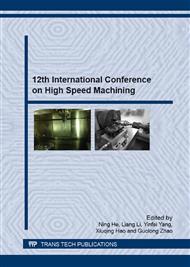[1]
V. Soleymani and B. eghbali, Grain Refinement in a Low Carbon Steel through Multidirectional Forging, J. Iron. Steel. Res. Int. 19 (2012) 74-78.
DOI: 10.1016/s1006-706x(12)60155-1
Google Scholar
[2]
H. Ding, N. Shen and Y. C. Shin, Predictive modeling of grain refinement during multi-pass cold rolling, J. Mater. Process. Tech. 212 (2012) 1003-1013.
DOI: 10.1016/j.jmatprotec.2011.12.005
Google Scholar
[3]
K. M. Lee and H. C. Lee, Grain refinement and mechanical properties of asymmetrically rolled low carbon steel, J. Mater. Process. Tech. 210(2010) 1574-1579.
DOI: 10.1016/j.jmatprotec.2010.05.004
Google Scholar
[4]
L. Zaharia, R. Chelariu and R. Comaneci, Multiple direct extrusion: A new technique in grain refinement, Mater. Sci. Eng. A 550 (2012) 293-299.
DOI: 10.1016/j.msea.2012.04.074
Google Scholar
[5]
B. Kim, C. H. Park and H. S. Kim, Grain refinement and improved tensile properties of Mg–3Al–1Zn alloy processed by low-temperature indirect extrusion, Scripta Mater. 76 (2014) 21-24.
DOI: 10.1016/j.scriptamat.2013.12.005
Google Scholar
[6]
R. Ma, K. Fang and J. G. Yang, Grain refinement of HAZ in multi-pass welding, J. Mater. Process. Tech. 214 (2014) 1131-1135.
DOI: 10.1016/j.jmatprotec.2013.12.017
Google Scholar
[7]
G. Sha, K. Tugcu and X. Z. Liao, Strength, grain refinement and solute nanostructures of an Al–Mg–Si alloy (AA6060) processed by high-pressure torsion, Acta Mater. 63 (2014) 169-179.
DOI: 10.1016/j.actamat.2013.10.022
Google Scholar
[8]
M. Alizadeh and M. Samiei, Fabrication of nanostructured Al/Cu/Mn metallic multilayer composites by accumulative roll bonding process and investigation of their mechanical properties, Mater. Design 56 (2014) 680-684.
DOI: 10.1016/j.matdes.2013.11.067
Google Scholar
[9]
L. Su, C. Lu and A. A. Gazder, Shear texture gradient in AA6061 aluminum alloy processed by accumulative roll bonding with high roll roughness, J. Alloy Compd. 594 (2014) 12-22.
DOI: 10.1016/j.jallcom.2014.01.125
Google Scholar
[10]
G. G. Maier, E. G. Astafurova and H. J. Maier, Annealing behavior of ultrafine grained structure in low-carbon steel produced by equal channel angular pressing, Mater. Sci. Eng. A 581 (2013) 104-107.
DOI: 10.1016/j.msea.2013.05.075
Google Scholar
[11]
J. T. Wang, C. Xu and Z. Z. Du, Microstructure and properties of a low-carbon steel processed by equal-channel angular pressing, Mater. Sci. Eng. A 410-411(2005) 312-315.
DOI: 10.1016/j.msea.2005.08.111
Google Scholar
[12]
T. L. Brown, S. Swaminathan and S. Chandrasekar, Low-cost manufacturing process for nanostructured metals and alloys, J. Mater. Res. 17 (2002) 2484-2488.
DOI: 10.1557/jmr.2002.0362
Google Scholar
[13]
S. Swaminatha, M. R. Shankar and S. Lee, Large strain deformation and ultra-fine grained materials by machining, Mater. Sci. Eng. A 410-411(2005) 358-363.
Google Scholar
[14]
W. Moscoso, M. R. Shankar and J. B. Mann, Bulk nanostructured materials by large strain extrusion machining, J. Mater. Res. 22 (2007) 201-205.
DOI: 10.1557/jmr.2007.0021
Google Scholar
[15]
L. D. Chiffre, Extusion-cutting, Int. J. Mach. Tool Des. Res. 16 (1976) 137-144.
Google Scholar
[16]
L. D. Chiffre, Extrusion cutting of brass strip, Int. J. Mach. Tool Des. Res. 23 (1983) 141-151.
Google Scholar
[17]
M. R. Shankar, S. Chandrasekar and W. D. Compton, Characteristics of aluminum 6061-T6 deformed to large plastic strains by machining, Mater. Sci. Eng. A 410-411 (2005) 364-368.
DOI: 10.1016/j.msea.2005.08.137
Google Scholar
[18]
C. Saldana, P. Yang, J. B. Mann, Micro-scale components from high-strength nanostructured alloys, Mater. Sci. Eng. A 503 (2009) 172-175.
DOI: 10.1016/j.msea.2008.02.056
Google Scholar
[19]
M. Efe, W. Moscoso and K. P. Trumble, Mechanics of large strain extrusion machining and application to deformation processing of magnesium alloys, Acta Mater. 60 (2012) 2031-(2042).
DOI: 10.1016/j.actamat.2012.01.018
Google Scholar
[20]
P. Iglesias, M. D. Bermudez and W. Moscoso, Friction and wear of nanostructured metals created by large strain extrusion machining, Wear 263 (2007) 636–642.
DOI: 10.1016/j.wear.2006.11.040
Google Scholar
[21]
P. Iglesias, M. D. Bermudez and W. Moscoso, Influence of processing parameters on wear resistance of nanostructured OFHC copper manufactured by large strain extrusion machining, Wear 268 (2010) 178–184.
DOI: 10.1016/j.wear.2009.07.009
Google Scholar
[22]
M. Furukawa, Z. Horita and M. Nemoto, Microhardness Measurement and the Hall-Petch Relationship in an Al-Mg Alloy with Submicrometer Grain Size, Acta Mater. 44 (1996) 4619-4629.
DOI: 10.1016/1359-6454(96)00105-x
Google Scholar
[23]
M. V. Markushev, C. C. Bampton and M. Y. Murashkin, Structure and properties of ultra-fine grained aluminum alloys produced by severe plastic deformation, Mater. Sci. Eng. A 234-236 (1997) 927-931.
DOI: 10.1016/s0921-5093(97)00333-x
Google Scholar
[24]
D. H. Shin, B. C. Kim, Y. S. Kim, Microstructural Evolution in a Commercial Low Carbon steel By Equal Channel Angular Pressing, Acta Mater. 48 (2000) 2247-2255.
DOI: 10.1016/s1359-6454(00)00028-8
Google Scholar
[25]
C. F. Yang, J. H. Pan, T. H. Lee, Work-softening and anneal-hardening behaviors in fine-grained Zn–Al alloys, J. Alloy Compd. 468 (2009) 230-236.
DOI: 10.1016/j.jallcom.2008.01.067
Google Scholar
[26]
Y. Zhang, L. Yang and X. Zeng, The mechanism of anneal-hardening phenomenon in extruded Zn–Al alloys, Mater. Design 50 (2013) 223-229.
DOI: 10.1016/j.matdes.2013.02.069
Google Scholar
[27]
I. Markovic, S. Nestorovic and D. Markovic, Properties improvement and microstructure changes during thermomechanical treatment in sintered Cu–Au alloy, Trans. Nonferrous Met. Soc. China 24 (2014) 431-440.
DOI: 10.1016/s1003-6326(14)63079-x
Google Scholar
[28]
Y. Ivanisenko, R. K. Wunderlich and R. Z. Valiev, Annealing behaviour of nanostructured carbon steel produced by severe plastic deformation, Scripta Mater. 49 (2003) 947-952.
DOI: 10.1016/s1359-6462(03)00478-0
Google Scholar


